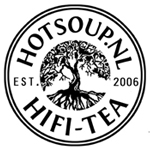Oriental Beauty, Bai Hao Wulong
Bai Hao Oolong (Wulong) is also called Dong Fang Mei Ren or Oriental Beauty. The tea comes from Hsinchu (Hsinju), Taiwan. The multicolored tea leaves are reminiscent of autumn leaves. This tea has been bitten by small locusts, Jacobiasca formosana, which causes the bitemarks on the leaves to oxidize already on the plant. After harvest the Bai Hao leaves are processed and heavily oxidized, more than most other Taiwanese Oolong teas. The result is a concentrated complex sweet tea reminiscent of dried red fruit, honey, peach and wood.
Bai Hao Wulong (Oolong) tea is also called Dong Fan Mei Ren, or Oriental Beauty in Taiwan and this one grows at an altitude of 1000 meters. The multicoloured tea leaves are reminiscent of autumn leaves. The name Bai Hao, white tips, indicates the small white leaf buds picked together with the top two leaves. The place where the tea grows in Taiwan is moist and foggy. These natural conditions determine the characteristic properties of the Bai Hao. After the harvest, the leaves of the Bai Hao are processed, heavily oxidized, more than most other Taiwanese Oolong teas. The result is a concentrated complex sweet tea with notes of currants and wood.
There are many stories about the origin of Bai Hao tea. According to a Taiwanese tea book, a tea farmer in Beipu had noted that small green insects, grasshoppers, damaged the leaves from a new spring harvest. Instead of destroying the tea, the farmer had decided to process the tea leaves into tea. He gave his tea to a local tea merchant, who was prepared to pay twice as much because of the delicious taste. The grasshoppers would cause the characteristic taste, as we noticed. Bai Hao is also known as "Dong Fang Mei Ren" or Oriental Beauty. The origin of this name dates back to the beginning of the 20th century. The then Queen Elizabeth II was offered this tea, and she was fascinated by the special aroma and taste of Bai Hao. Because of the beautiful appearance of the tea, just like a beautiful lady, and its origins, the late Queen called it 'Oriental Beauty'.
| SKU | O-107-HE |
|---|---|
| Stock | Permanent collection |
| Tea Type | OOLONG TEA |
| Certification | Certificate of Analysis |
| Flavours | Woods, woodsy, Fruity, dried fruit, Roasted, brown, Sweet, honey |
| Origin | --> TAIWAN |
| Harvest | 2023 |
| Brewing western | Oolong tea: Use 2 grams of tea per cup (200ml) and brew medium to hot, around 80° to 100°C, allow to steep for 3-5 minutes and infuse at least 3 times. |
| Brewing eastern | Use 3 grams of tea per 100ml of water, the water temperature is between 90 and 100 ° C and short steeps of around 10 seconds. It's best to use a small teapot or gaiwan. |
| Grandma's tea | For an old-fashioned cup of tea from a teapot with a strainer, relaxed and economical. Use approximately 7 grams of tea per liter of boiling water and let it steep for about 7 minutes, Suitable for all teas except green tea. or longer if the tea can take |
| Cold Brew | Cold infusion, use 10 to 16 grams of tea per liter of cold water. Let the tea steep overnight in the fridge, 12 to 15 hours. You can vary with the proportions for example to add sparkling water afterwards. |
| Shelf life | Store this product cool, dark, dry and airtight; after a year the fresh taste develops into a more mellow taste. |

